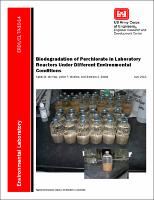Please use this identifier to cite or link to this item:
https://hdl.handle.net/11681/6956| Title: | Biodegradation of perchlorate in laboratory reactors under different environmental conditions |
| Authors: | Morrow, Agnes B. Medina, Victor F. Extine, Barbara A. |
| Keywords: | Ammonium perchlorate Biodegradation |
| Publisher: | Environmental Laboratory (U.S.) Engineer Research and Development Center (U.S.) |
| Series/Report no.: | ERDC/EL ; TR-10-14. |
| Abstract: | Batch microcosm reactor studies using aquifer sand collected from a perchlorate-contaminated site were conducted in order to determine if perchlorate can be treated using in situ biodegradation stimulated by an organic electron donor, acetate, and to measure degradation rates over a range of environmental variables. The addition of acetate as an organic substrate stimulated rapid perchlorate degradation after a lag phase, presumably resulting from microbial acclimation. The lag phase was eliminated after previous exposure or after microbes consumed the oxygen and the reactors went anaerobic. Perchlorate degradation was effective when greater than 50 mg/L acetate was added, at temperatures greater than 20°C, and when the pH was between 4 and 8. Various perchlorate and acetate concentrations had different effects on the biodegradation process. Most of the studies were conducted at relatively high (mg/L) concentrations. To investigate removal at lower concentrations, a study with an initial perchlorate concentration of 50 μg/L was conducted, and this indicated that final treatment concentrations were reduced below the California maximum contaminant level (MCL) of 6 μg/L. Chloride was the ultimate end product of perchlorate degradation, and measurements indicated that chloride formation accounted for 95.5 to 100% of the perchlorate degraded. |
| Description: | Technical Report |
| URI: | http://hdl.handle.net/11681/6956 |
| Appears in Collections: | Technical Report |
Files in This Item:
| File | Description | Size | Format | |
|---|---|---|---|---|
| EL-TR-10-14.pdf | 542.66 kB | Adobe PDF |  View/Open |